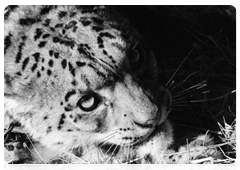MULTIMEDIA
 +
+
The word used in Russian for snow leopard, irbis, entered the language in the 17th century through Russian fur traders, who first learnt it from Turkic hunters
 +
+
In the Red Book of the USSR, its first edition published in 1978, the snow leopard was classified as 3rd-category, meaning a rare species with a limited habitat
 +
+
The most densely populated protected snow leopard habitat in Russia is currently the Sayano-Shushensky State Nature Reserve
 +
+
Due to the snow leopard’s remote habitat and sparse population, there has been limited research into critical aspects of the animal’s life
 +
+
In the 2001 release of the Red Book of Russia (Animals), the species was uplisted to the 1st category, which means it faces a risk of extinction
 +
+
Тhe Snow Leopard Programme research initiative aims to give efforts to preserve the rare species a firm basis in science
 +
+
Launched in 2010, the Siberian Snow Leopard programme is to be implemented within five years’ time
 +
+
The main objective of the programme is to assess the status of the snow leopard population across its entire habitat range in Russia and develop a scientific framework to ensure its long-term preservation in southern Siberia
 +
+
One of the project’s primary tasks is to raise awareness about snow leopard conservation efforts among communities in southern Siberia
 +
+
The Russian Geographical Society’s Khakassia branch provides assistance to researchers working in the nature preserves Khakassky and Pozarym
 +
+
Over the last six months, researchers have installed more than a hundred camera traps, which are equipped with motion sensors, so they take a picture of any object that crosses their path
 +
+
Camera traps will be used to count the population of snow leopards and their prey as well as to trace the migratory patterns of both
 +
+
The help of satellite tracking collars will enable researchers to learn more about the migration of leopards and their relations within home ranges
 +
+
The snow leopard programme involves an analysis of the habitat range and the seasonal migration patterns of the leopard population
 +
+
The researchers intend to coordinate their biological research and population count with fellow scientists involved in snow leopard research in neighbouring countries, notably Mongolia, China, and Kazakhstan
 +
+
These big brownish-grey cats with large dark-brown rosettes differ from leopards proper (Panthera pardus) by the colour and rich texture of their fur
 +
+
Snow leopards are found in the mountains of Central Asian (Himalayas) and southern Siberia at middle to high altitudes
 +
+
Snow leopards mark the territory in a variety of ways, and they make regular rounds of their hunting grounds, always moving along the same paths
 +
+
The snow leopard is at the top of the food pyramid, with rival predators offering little to no competition
































 ABOUT THE PROGRAMME
ABOUT THE PROGRAMME
 SNOW LEOPARD RESEARCH: A HISTORY
SNOW LEOPARD RESEARCH: A HISTORY
 SNOW LEOPARD: LIFE, BEHAVIOUR AND MORE
SNOW LEOPARD: LIFE, BEHAVIOUR AND MORE
 VLADIMIR PUTIN'S VISIT
VLADIMIR PUTIN'S VISIT
 NEWS
NEWS
 MULTIMEDIA
MULTIMEDIA